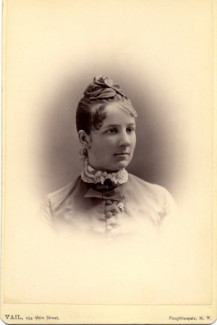
Johns Hopkins UniversityEst. 1876
America’s First Research University
Now Browsing:
Happy birthday, Emily Jordan Folger
Guest post by Stephen H. Grant
Emily Jordan was born in Ironton, Ohio on May 15, 1858. Following her two older sisters to Vassar College, she emerged a bluestocking: a refined lady with intellectual, scholarly, and literary interests. Emily’s Vassar 1879 class of 36 students elected her class president for life. Although her undergraduate scrapbook attests to a few dates with nearby West Pointers, she met her husband to be in Brooklyn at a literary salon in the home of Charles Pratt, founder of the Pratt Institute. Henry Folger also graduated in 1879, from Amherst College, where he roomed with Charles Pratt Jr. Both Emily and Henry earned Phi Beta Kappa keys. Neither Emily’s nor Henry’s parents attended college.
Emily took one of the few jobs open to young women, teaching. She taught in the collegiate department at the Nassau Institute—Miss Hotchkiss’s school for young ladies—in Brooklyn. When she married Henry in 1885, she was obliged to give up her teaching job. For the next half century, Emily served as a full partner in one of the most prodigious literary feats of all time: assembling the largest collection of Shakespeare in the world.
Henry Folger corresponded with 600 booksellers, 150 in London alone. The underground vault of the Folger Shakespeare Library contains 258 linear feet of auction catalogs which arrived at Henry’s office, 26 Broadway in Manhattan, home of the Standard Oil Company where he worked for five decades. When he brought the catalogs home to Emily in their Bedford-Stuyvesant brownstone, her job was to identify the items she wanted in their collection. Henry put together a bid list, and paid for the winning lots from his oil fortune. Then Emily wrote up each item for the card catalog, developing writer’s cramp along the way.
A childless couple, the Folgers were singlemindedly devoted to the Bard. They received family only twice a year: Thanksgiving and January 1. Nieces remember that on these sparse occasions, their aunt expected them to recite poetry and rewarded them with a book with a five-dollar bill tucked inside. The Folgers attended no social events nor hosted any business dinners. When they went on vacation in Virginia, they lugged a special travel card catalog around with them. On their numerous voyages to England, they attended Shakespeare performances, went book hunting, and brought back poppy seeds from Stratford-upon-Avon.
Emily was a close adviser to her husband in the acquisition of eighty-two Shakespeare First Folios, the 1623 compilation of thirty-six plays, eighteen of which might have been lost to the world as they had not been printed. Emily had earned a masters degree at Vassar with a thesis on “The True Text of Shakespeare,” pointing to the 1623 publication as the most authoritative edition of the plays. Emily kept a fascinating play diary, where she wrote pages and pages of detail concerning the 125 Shakespeare plays she saw in her lifetime.
In 1919, the Folgers started buying up the fourteen redbrick rowhouses two blocks from the U.S. Capitol on land they had identified for a permanent repository for their Shakespeare collection. Each of the deeds noted Emily Jordan Folger as owner. She also held in her name bank vault and storage warehouse accounts where they stored books, manuscripts, playbills, prints, engravings, paintings, pieces of furniture, porcelain, armor, maps, charts, phonograph records, costumes, globes, musical instruments, and curios. Henry stayed beneath the radar.
In the late 1920s the Folgers continued their aggressive buying of Shakespeare items, but made the time to help design what would become the Folger Shakespeare Library with French-born architect, Paul Philippe Cret. They selected quotations to be etched in stone. They identified scenes from Shakespeare’s plays for relief sculptures on the library façade.
It was Emily’s Day on April 23, 1932, the 368th celebration of Shakespeare’s birthday, when, wearing a shoulder corsage of orchids, and lilies of the valley over her academic robe, she turned over the keys of the Folger Shakespeare Library to the chairman of the board of Amherst College, who was responsible for the administration of the Folger. Henry was not present. He had died suddenly two weeks after the cornerstone was laid. He had never seen one stone of his library. He had never seen all his books and Shakespeare treasures assembled together under one roof. Seamlessly, Emily took over the mantle to make the research library a reality. She died in 1936. The Folgers’ ashes are in urns behind a bronze plaque in the reading room. The Folger is a library, a theatre, and a mausoleum.
 Stephen H. Grant is the author of Collecting Shakespeare: The Story of Henry and Emily Folger, published by Johns Hopkins. He is a senior fellow at the Association for Diplomatic Studies and Training and the author of Peter Strickland: New London Shipmaster, Boston Merchant, First Consul to Senegal.
Stephen H. Grant is the author of Collecting Shakespeare: The Story of Henry and Emily Folger, published by Johns Hopkins. He is a senior fellow at the Association for Diplomatic Studies and Training and the author of Peter Strickland: New London Shipmaster, Boston Merchant, First Consul to Senegal.
 Stephen H. Grant is the author of Collecting Shakespeare: The Story of Henry and Emily Folger, published by Johns Hopkins. He is a senior fellow at the Association for Diplomatic Studies and Training and the author of Peter Strickland: New London Shipmaster, Boston Merchant, First Consul to Senegal.
Stephen H. Grant is the author of Collecting Shakespeare: The Story of Henry and Emily Folger, published by Johns Hopkins. He is a senior fellow at the Association for Diplomatic Studies and Training and the author of Peter Strickland: New London Shipmaster, Boston Merchant, First Consul to Senegal.
Login to View & Leave Comments
Login to View & Leave Comments



